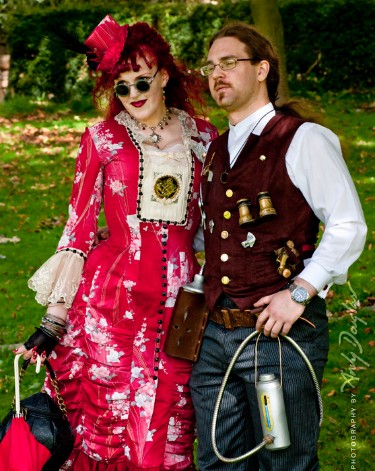
Pictures by Andy Idophotos Woodhouse of steampunks attending "Weekend at the Asylum" 2010 |
|
I first wrote an article trying to explain what Steampunk is a couple of years ago. It proved to be very popular indeed and has been quoted in several subsequent works, articles etc. Both steampunk and my understanding of steampunk have moved on since then so this is a redraft and expansion of that original article.
Well to begin with let's clear up the name. "Steampunk" started as a joke. There was a movement in science fiction to write in a genre known as "Cyberpunk". When various writers began exploring similar concepts and ideas but setting them in a pseudo Victorian world one of those writers, K.W. Jeter jokingly coined the term "steampunk". As a tongue in cheek descriptor it stuck.
The name DOES NOT define the genre. Nor is 1987 the genesis of the scene. Steampunk has been a feature of Western Culture since the Victorian age itself. Jules Verne, HG Wells, even Mary Shelley and Bram Stoker have contributed to the wealth of imagery and ideas which steampunks enjoy so much. Of course since then there have been an absolute multitude of other influences from movies such as Chitty Chitty Bang Bang and Wild Wild West to comic books, novels, music bands and tinkerers. What Steampunks should thank Jeter for is coming up with a name which serves as a signpost to help them to find people with similar interests and tastes.
Steampunk has now developed into an extended network which encompasses a wide variety of input from a highly creative and artistic community. It includes writers, musicians, dancers, sculptors, model makers, costume makers and a host of other disciplines and skills. It has been summed up as "Well can you imagine what things would be like if the Great Exhibition had never finished?" Steampunks try to take some of the very best parts of the past and make them part of a bright future. Steampunks value good manners and polite conduct and try to encourage this by setting an example for others. They think things should be made to a high quality and to last thus helping the environment. They value and encourage creativity and indeed have been asked to collaborate in educational and arts projects across the globe.
Whilst things are set in a pseudo historical world which harks back to our Victorian heritage steampunks do not promote any of the inequalities of that past. Indeed theirs is deliberately an all inclusive community. You will find steampunks of all ages, genders and ethnic backgrounds and abilities. They also come from all walks of life from students to academics and from comedians to solicitors.
Can you still call it steam-PUNK? Punk in the seventies was a rebellion against contemporary society. It is plain that steampunks are rebelling but theirs is a stand against: throwaway society, poor manners and antisocial behaviour, homogenisation and commercialism.
Steampunks are generally polite, friendly, care about the environment , the past and the future and creativity and individuality.
Steampunk started as a science fiction genre but it is now a community and has its own fashions, music and tastes. It is a community that enjoys socialising, often dressing in distinctive steampunk fashions. You may see steampunks visiting historical sites as well as enjoying music gigs and performances. Steampunks often make or modify everyday objects to fit the neo victorian aesthetic. This could be making a wood and brass cabinet for your PC or a mock raygun suitable for an adventure with Jules Verne.
The DIY ethic is very strong in steampunk. With creativity being the main common denominator this is hardly surprising. It also fits in with ther philosophies on sustainability, durability and craftsmanship. It is more environmentally friendly to take an object and repurpose it giving it a whole new lease of life than to recycle it.
In a recent exercise to "explain steampunk in a sentence" a group from across the world came up with:
"Steampunk is a creative social movement that draws inspiration from Victorian and pre-war history in an anachronistic mix of science fiction, modern values and a sense of fun."
Whilst this doesn't explain it all it is a fine place to start and gives a good idea of what it is about. To get a handle on the flavour of the scene the same exercise also produced:
"Steampunk is nostalgia for what never was!"
It should be very swiftly pointed out that neither of these statements, nor indeed this article, acts to define steampunk. This has proven to be an impossible task. Steampunk is a very personal thing and everyone's idea of what it should be is individual to them. The sign of a steampunk who is confident in the community is that they are prepared to acknowledge that there is no definition and no boundaries to steampunk other than the imagination of the individual.
There is however one rule.
BE NICE TO ONE ANOTHER.
This should suffice.
Tinker, July 2011

